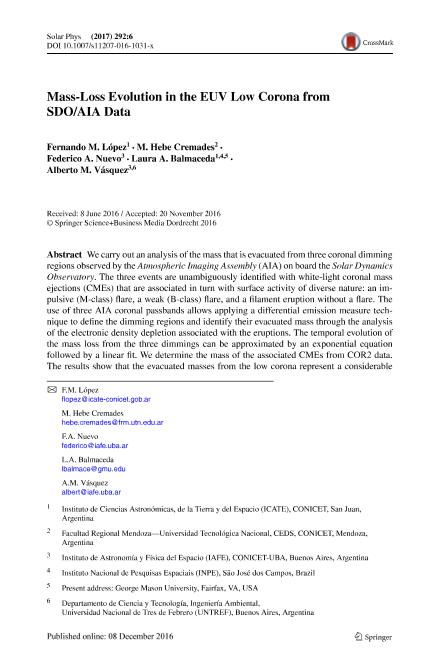Mostrar el registro sencillo del ítem
dc.contributor.author
López, Fernando Marcelo

dc.contributor.author
Cremades Fernandez, Maria Hebe

dc.contributor.author
Nuevo, Federico Alberto

dc.contributor.author
Balmaceda, Laura Antonia

dc.contributor.author
Vasquez, Alberto Marcos

dc.date.available
2018-11-21T18:15:24Z
dc.date.issued
2017-01
dc.identifier.citation
López, Fernando Marcelo; Cremades Fernandez, Maria Hebe; Nuevo, Federico Alberto; Balmaceda, Laura Antonia; Vasquez, Alberto Marcos; Mass-Loss Evolution in the EUV Low Corona from SDO/AIA Data; Springer; Solar Physics; 292; 6; 1-2017; 1-19
dc.identifier.issn
0038-0938
dc.identifier.uri
http://hdl.handle.net/11336/64873
dc.description.abstract
We carry out an analysis of the mass that is ejected from three coronal dimming regions observed by the Atmospheric Imaging Assembly (AIA) on board the Solar Dynamics Observatory. The three events are unambiguously identified with white-light coronal mass ejections (CMEs) that are associated in turn with surface activity of diverse nature: an impulsive (M-class) flare, a weak (B-class) flare, and a filament eruption without a flare. The use of three AIA coronal passbands allows applying a differential emission measure technique to define the dimming regions and identify their ejected mass through the analysis of the electronic density depletion associated with the eruptions. The temporal evolution of the mass loss from the three dimmings can be approximated by an exponential equation followed by a linear fit. We determine the mass of the associated CMEs from COR2 data. The results show that the ejected masses from the low corona represent a considerable amount of the CME mass. We also find that plasma is still being ejected from the low corona at the time when the CMEs reach the COR2 field of view. The temporal evolution of the angular width of the CMEs, of the dimming regions in the low corona, and of the flux registered by GOES in soft X-rays are all in close relation with the behavior of mass ejection from the low corona. We discuss the implications of our findings toward a better understanding of the temporal evolution of several parameters associated with the analyzed dimmings and CMEs.
dc.format
application/pdf
dc.language.iso
eng
dc.publisher
Springer

dc.rights
info:eu-repo/semantics/openAccess
dc.rights.uri
https://creativecommons.org/licenses/by-nc-sa/2.5/ar/
dc.subject
Corona, Active
dc.subject
Coronal Mass Ejections
dc.subject
Flares
dc.subject
Low Coronal Signatures
dc.subject.classification
Astronomía

dc.subject.classification
Ciencias Físicas

dc.subject.classification
CIENCIAS NATURALES Y EXACTAS

dc.title
Mass-Loss Evolution in the EUV Low Corona from SDO/AIA Data
dc.type
info:eu-repo/semantics/article
dc.type
info:ar-repo/semantics/artículo
dc.type
info:eu-repo/semantics/publishedVersion
dc.date.updated
2018-10-22T17:30:33Z
dc.identifier.eissn
1573-093X
dc.journal.volume
292
dc.journal.number
6
dc.journal.pagination
1-19
dc.journal.pais
Alemania

dc.journal.ciudad
Berlin
dc.description.fil
Fil: López, Fernando Marcelo. Consejo Nacional de Investigaciones Científicas y Técnicas. Centro Científico Tecnológico Conicet - San Juan. Instituto de Ciencias Astronómicas, de la Tierra y del Espacio. Universidad Nacional de San Juan. Instituto de Ciencias Astronómicas, de la Tierra y del Espacio; Argentina
dc.description.fil
Fil: Cremades Fernandez, Maria Hebe. Consejo Nacional de Investigaciones Científicas y Técnicas; Argentina. Universidad Tecnológica Nacional. Facultad Regional de Mendoza; Argentina
dc.description.fil
Fil: Nuevo, Federico Alberto. Consejo Nacional de Investigaciónes Científicas y Técnicas. Oficina de Coordinación Administrativa Ciudad Universitaria. Instituto de Astronomía y Física del Espacio. - Universidad de Buenos Aires. Facultad de Ciencias Exactas y Naturales. Instituto de Astronomía y Física del Espacio; Argentina
dc.description.fil
Fil: Balmaceda, Laura Antonia. Consejo Nacional de Investigaciones Científicas y Técnicas. Centro Científico Tecnológico Conicet - San Juan. Instituto de Ciencias Astronómicas, de la Tierra y del Espacio. Universidad Nacional de San Juan. Instituto de Ciencias Astronómicas, de la Tierra y del Espacio; Argentina. Centro de Previsao de Tempo e Estudos Climáticos. Instituto Nacional de Pesquisas Espaciais; Brasil. George Mason University; Estados Unidos
dc.description.fil
Fil: Vasquez, Alberto Marcos. Consejo Nacional de Investigaciónes Científicas y Técnicas. Oficina de Coordinación Administrativa Ciudad Universitaria. Instituto de Astronomía y Física del Espacio. - Universidad de Buenos Aires. Facultad de Ciencias Exactas y Naturales. Instituto de Astronomía y Física del Espacio; Argentina. Universidad Nacional de Tres de Febrero; Argentina
dc.journal.title
Solar Physics

dc.relation.alternativeid
info:eu-repo/semantics/altIdentifier/doi/https://dx.doi.org/10.1007/s11207-016-1031-x
dc.relation.alternativeid
info:eu-repo/semantics/altIdentifier/url/https://link.springer.com/article/10.1007/s11207-016-1031-x
Archivos asociados
